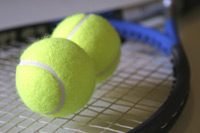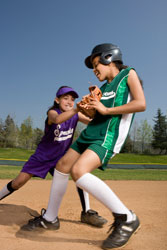Section navigation
Sports and recreation
- Physical activity comes in many forms
- Important physical activity tips
- How to find activities and sports
- Questions to ask about fitness or exercise programs
- Tips for playing sports differently to meet your needs
- Some specific fitness options
- Other organizations that offer activities and sports
- Helpful Tools
Physical activity comes in many forms
Types of exercise include:
- Swimming laps
- Taking a walk
- Playing wheelchair basketball
- Walking up the stairs
Important physical activity tips:  top
top
- Before you start any physical activity program, talk to your doctor to make sure that it is okay. Your doctor will help you be active in the safest way possible.
- Make sure you stop being physically active or playing a sport if you feel pain, feel sick, feel dizzy, or are short of breath.
- Make sure to drink plenty of water before, during, and after you are physically active.
How to find activities and sports:  top
top
Your community probably has many places where you can take part in activities you love and even try new ones. To start, call your city’s recreation department, your own school, health clubs, YWCA, the local Girls Scout council, and nearby colleges. They might have pools, sports teams, exercise rooms, and more. You can also call the local Chamber of Commerce to find out where else you can find programs in your area.
Another place to try calling is your nearby Center for Independent Living (CIL) . CILs are agencies staffed mainly by people with disabilities. They know all about resources in your community for people with disabilities. See below for questions to ask when you call these places.
Questions to ask about fitness or exercise programs:  top
top
- Where are you located?
- What sports teams, games, programs, or exercise equipment do you offer?
- How much does it cost?
- How can I apply for financial help if I need it?
- What are the times and dates of your programs?
- How do you register?
- Are your facilities and programs accessible to people with disabilities?
- Do you have any adaptive equipment or tools that people with disabilities can use?
- Do you have anyone on the staff who can help people with disabilities use your facilities? (These people are sometimes called "inclusion aides.")
- Do you have any programs that are just for people with disabilities?
- Can teenagers use the facility?
Tips for playing sports differently to meet your needs:  top
top

- Soccer: Walk instead of run if you need to, or hold the ball in your lap if you use a wheelchair.
- Volleyball: Use a larger ball that is softer or brightly colored, or allow the ball to bounce on the ground before hitting it.
- Bowling: Use two hands instead of one, or use a ramp.
- Tennis: Use a racquet with a large head, or don't use a net.
For many sports, you could try using an inclusion aide. An inclusion aide is a person who helps people with disabilities participate in sports and other activities. For example, if you are interested in horseback riding but have an illness or disability that makes this hard for you to do alone, an inclusion aide would assist you.
Some specific fitness options:  top
top
People of all levels of ability can find sports and activities that suit them. Find out if one of these is right for you:
- Interested in dance? Check out AXIS Dance Company’s program for girls with and without disabilities.
- Do you love horses? Visit the North American Riding for the Handicapped Association , which serves horseback riders with disabilities across the United States and Canada.
- Has it always been your dream to skate? If so, visit the Skating Athletes Bold at Heart website . The association teaches people who are physically, emotionally, or mentally challenged how to ice skate.
- Could you be a future Olympian? If the answer is yes, the Special Olympics can offer you an amazing experience. Learn more about this competition for children and adults with intellectual disabilities . On their website, you can also read about some of the Special Olympics athletes .
- Fitness can be relaxing. Yoga for the Special Child offers yoga for kids who have special needs such as Down syndrome, cerebral palsy, autism, attention deficit hyperactivity disorder, and learning disabilities, and other conditions.
- Want to go on hiking trails in a wheelchair? Call a national park or state park and ask if they have any paved hiking trails .
Other organizations that offer activities and sports:  top
top
- Adaptive Adventures has links to youth programs and camps around the country.
- BlazeSports provides training and competition for people with physical disabilities.
- Deaflympics
- Disabled Sports USA
- Let’s Move offers fun tips and tools from the government.
- National Ability Center
- National Center on Physical Activity and Disability
- National Sports Center for the Disabled
- National Wheelchair Basketball Association (Check out the Youth Sports Corner)
- The Amputee Coalition of America
- USA Deaf Sports Federation
- U.S. Paralympics Team
- United States Association of Blind Athletes
- United States Handcycling Federation
- Wheelchair and Ambulatory Sports USA
Helpful Tools  top
top
- The National Institute of Diabetes and Digestive and Kidney Diseases has helpful tips for teenagers on eating healthy and physical activity .
- Here are some tips on being physically active if you have arthritis.
Content last reviewed February 16, 2011
Page last updated December 26, 2014








